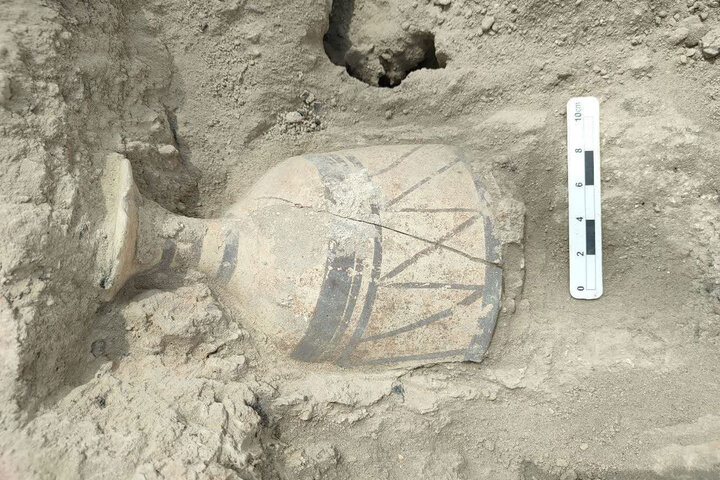2,700-year-old metalworking workshop discovered in heart of Iran

TEHRAN - A 2,700-year-old metalworking workshop has recently been unearthed in Tepe Sialk during a reassessment project conducted on the archaeological site which is situated near Kashan, central Iran.
The discovery was part of the third season of excavations conducted at the 8,000-year-old site, one of the oldest in Iran.
The one-month project, which began on August 15, was a collaboration between Kashan University, the National Museum of Iran, and the Ministry of Cultural Heritage, Tourism, and Handicrafts.
On Sunday, Javad Hosseinzadeh Sadati, head of the Tepe Sialk Cultural Heritage Base, confirmed the findings, revealing that in addition to the metalworking workshop, archaeologists unearthed remains of an ancient oven and well-preserved pottery dating back to the third phase of Sialk civilization.
“Alongside the workshop and other artifacts, we found evidence of industrial spaces from the third period of the Sialk era (Sialk III),” Hosseinzadeh Sadati said.
Around 25 archaeology students from universities across Iran, including the University of Tehran, Tarbiat Modares, the University of Kashan, Shahid Beheshti, and Isfahan Art University, participated in the excavation.
Tepe Sialk is renowned for its historical significance, spanning from early village settlements to the Median Empire. Hosseinzadeh Sadati expressed hope that the site would ultimately gain a UNESCO recognition, adding, “Tepe Sialk is one of the most treasured archaeological sites in Iran and the world, holding evidence of human civilization dating back nearly 8,000 years.”
A window into ancient civilizations
Tepe Sialk was first excavated during three seasons in 1933, 1934, and 1937 by a team led by Roman Ghirshman and his wife, Tania Ghirshman. The site is divided into two main mounds, referred to as the northern and southern hills, each with six distinct levels of civilization:
Sialk I
Sialk I represents the oldest and deepest layer of the site. According to Ghirshman’s research, the early inhabitants built their straw-and-branch cottages and covered them with mud. They also produced pottery using specialized ovens, a notable development in their daily lives.
Sialk II
During this period, the people of Sialk created pottery adorned with images of plants and animals, each with symbolic meanings. The community largely consisted of shepherds, hunters, and farmers. Remarkably, they discovered copper, which they used to craft small items, such as jewelry.
One unique cultural practice of this era was the burial of the deceased within their homes. Bodies were covered in red clay and buried with personal valuables, reflecting the beliefs and customs of the time.
Sialk III
Approximately 6,100 years ago, the inhabitants of Sialk migrated from the northern hill to the southern hill, although they continued their tradition of burying the dead beneath the floors of their homes. This period saw the introduction of the pottery wheel, marking a significant advancement in craftsmanship, which likely corresponded to a growing population and increased demand for goods.
The people of this era drew inspiration from human figures in their designs and modernized their jewelry by incorporating silver as a primary material.
Sialk IV
Between 5,100 and 4,600 years ago, major cultural advancements took place at Sialk. The discovery of cylindrical seals featuring animals and geometric shapes indicates the development of literacy and trade. These seals suggest that Sialk had become a hub of economic activity, likely spurred by the region’s growing population.
Sialk V
Around 3,200 years ago, a new wave of migrants arrived at Tepe Sialk, bringing with them distinctive gray pottery. This era saw a departure from the tradition of burying the dead within homes; instead, the people established cemeteries on the southern side of the settlement. These burial sites included valuable personal belongings, reflecting a belief in the afterlife.
Sialk VI
The final phase of Sialk witnessed the construction of new homes and cemeteries by yet another group of migrants. Burial practices evolved, with graves taking on a mound-like shape. More than 200 graves from this era have been discovered, providing further insights into the funerary customs of the time.
In 2019, the Louvre hosted an international conference on the Sialk Hills, drawing archaeologists from Iran, Germany, England, and France. The event sought to shed new light on the site, more than 80 years after its initial excavation. The conference focused on the diversity of research surrounding Tepe Sialk, along with efforts to preserve and enhance this important historical landmark.
AM
Leave a Comment